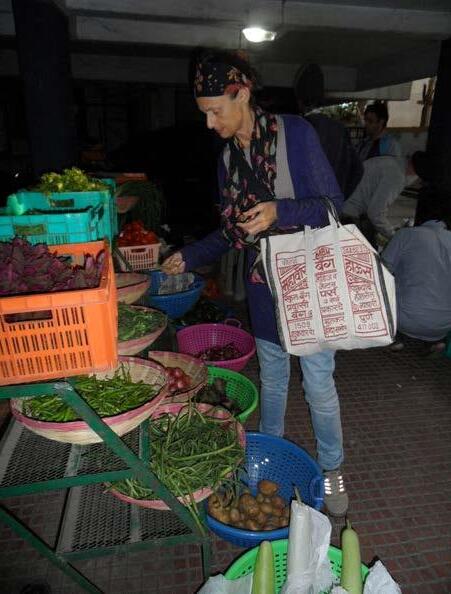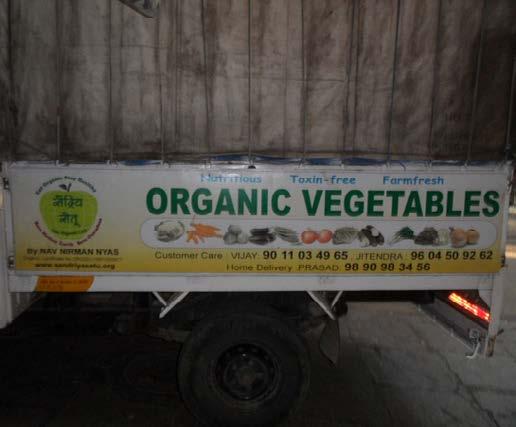
6 minute read
Our Yoga Carbon Footprint
By Laura Potts
How much of our yoga associated activities are at odds with our first principle of ahimsa ? And how can we change those practices and find ways to make our yoga a less damaging activity? We can limit fuel use and flying in particular, so not embarking on ‘yoga tourism’ to lovely destinations overseas; we can choose non oil-based derivatives for equipment, which are so much more widely available now; use fairly traded organic cotton for clothing, and so on. It’s an interesting and revealing exercise to calculate your carbon footprint, factoring in yoga related activities and choices. There is a good tool available at https://footprint.wwf.org.uk/#/, which analyses your result and suggests areas that can be improved.
Travelling to RIMYI
Going to RIMYI in Pune has, of course, a gigantic carbon footprint. There are various ways we can try to mitigate the harmful effects on the environment, and many people will think of carbon offsetting schemes for the travel involved. These are quite controversial, and some have argued that they basically exonerate our guilty consciences, rather than positively contributing to carbon savings. And even robust schemes (tree planting has long since been superseded by green energy schemes) are hard to evaluate – and the real objective has to be that we minimise our himsa activities and carbon emissions across the board. But environmental NGOs have worked hard in recent years to set a ‘gold standard’ for offsetting schemes, so if you decide to go to RIMYI there are ways at least to offset some of the harm caused by the journey, making use of, for instance, the Voluntary Gold Standard (VGS). VGS-certified offsets are audited according to the rules laid out in the Kyoto protocol and must also show social benefits for local communities. As a starting point, have a look at https://www.goldstandard.org/take-action/offset-youremissions.
Plastic reduction
In Pune, we can refuse all plastic bags and bottles very easily – and when you see the waste dumped in open spaces, often foraged by poor children, and burned on winter fires, you will surely want to. It’s great to learn from a recent visitor that this is now a recognised problem, with airlines into Mumbai urging passengers to forego all disposable plastics. The first time I was in Pune, shopping at the market stalls, the kids used to run after guidelines. The city is taking an active role in responding to the public health challenge posed by air pollution by drawing on local expertise. That local knowledge includes…. an innovative air quality monitoring and forecasting effort, the System of Air Quality and Weather Forecasting and Research (SAFAR)’. We can choose to walk, rather than ride a rickshaw when possible – or, if you feel that would deny local employment, then share a ride with other students.
Food choices
We can make the choice to buy local food –not imported treats; the quality of fruit and vegetables is excellent. Last time I was there, in 2014, there was a wonderful small market early on a Sunday morning on Apte road. Sendriya Setu bring in amazing fresh organic produce grown within 50k of Pune, which is me teasing ‘No plastic, no plastic, madam!’, because that was what I always said to stall holders! One of those stall holders thanked me, saying this should be the way for India.

When you experience the air pollution, and learn of the ill-health suffered by people because of it (there are some excellent research projects at Pune and Mumbai universities on this), you will want to support the efforts of local people to limit polluting activities. Pune’s population is now about 7 million people, and the city has grown rapidly in recent years. According to NRDC (see https://www.nrdc.org/experts/vijay-limaye/pune-expands-city-efforts-fight-dangerousair-pollution), ‘air quality in the city remains a stubborn challenge: levels of fine particulate matter (PM2.5) regularly exceed both Indian standards and World Health Organization all gone by 9am! They also sell a range of dry groceries, pulses, grains and flours. Find them online https://www.greenecosystem.in/fconn/organic-fruit-vegetable-supplier/sendriyasetu-organic-supplier.html or phone to check stall days.
Tree planting
By way of practical engagement to make a difference, I recommend a tree planting project on the hills of Pune. Whenever I have visited, I have enjoyed walking there as intense city living feels very oppressive. Last time I was there I met a few people on a Sunday morning carrying water to small saplings in the dry, bare earth, and in conversation I learned about this project set up by some of Guruji’s students: Dr. Chandrakant and Dr. Kusum Garudkar. Reading the obituary of Dr Chandrakant in Yoga Rahasya, I got in touch with the project suggesting RIMYI visitors might help; here are parts of the very moving responses I had:
M.M:This is indeed a noble thought. I am sure if each one of us thinks like this, we will soon be able to limit the build up of CO2 in the atmosphere.
Vasundhara Pratishthan is a modest but committed group of local citizens from in and around Baner who care for the environment and are doing their bit to make a change and stop degradation of the environment caused largely by human endeavour. This group was started and nurtured by Dr. Chandrakant and his wife Dr. Kusum Garudkar. This group believes in action … one more principle they have enshrined is to plant only indigenous species of trees. This has much larger benefit to the environment because of the symbiotic relations these trees have with local flora and fauna.
N.B. I'm very happy that you are really thinking deep for the various issues and willing to help, this is very good for the mother earth.
We work on every Sunday, we can meet at Dhanvantari Hospital, Baner City, Baner road. The nearest landmarks are "Fasoos Food Shop", "Cafe Coffee Day", "Cosmos Bank" etc. Ask any auto rickshaw driver for this hospital and they will guide you. We typically work from 7-9.30am every Sunday.

So, if you plan a trip to RIMYI, do get in touch with Narendra Bhagwat (bhagwatn@gmail(dot)com), make a donation to the project and spend a few hours helping trees to grow once more on the Pune hills – for beauty, for shade, for the soil, for the air quality, for the delight of growing things and pleasure in connecting to Pune citizens.
From an article originally published in SADIYA newsletter, October 2016.
With thanks to Frances Homewood for providing updates on Pune hills tree planting on her recent visit.
All photos by Laura Potts

